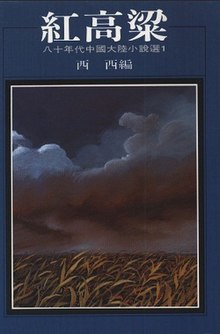 First edition (Chinese) First edition (Chinese) | |
| Author | Mo Yan |
|---|---|
| Original title | 红高粱家族 Hong Gao Liang Jia Zu |
| Translator | Howard Goldblatt (1993) |
| Language | Chinese |
| Set in | 20th-century Shandong |
| Publication date | 1986/1987 |
| Publication place | China |
Red Sorghum: A Novel of China (simplified Chinese: 红高粱家族; traditional Chinese: 紅高粱家族; pinyin: Hóng Gāoliáng Jiāzú; lit. 'red sorghum family') is a Chinese-language novel by Mo Yan. Its five parts were published serially in various magazines in 1986 and republished together as a single novel in 1987. It was Mo's first novel and remains one of his best-known works.
The novel is a compilation of five novellas: "Red Sorghum", "Sorghum Wine", "Dog Ways", "Sorghum Funeral", and "Strange Death". "Red Sorghum" was published in People's Literature (Issue 3, 1986), "Dog Ways" was published in the April 1986 issue of Shiyue ("October" magazine); "Sorghum Wine" in the July 1986 issue of PLA Arts, "Sorghum Funeral" in the August 1986 issue of Beijing Wenxue and "Strange Death" in the November–December issue of Kunlun magazine. The novel was translated from the Chinese by Howard Goldblatt in 1993 as Red Sorghum: A Novel of China, but has also been referred to as "The Red Sorghum Clan" in some sources.
Red Sorghum's plot revolves around three generations of the Shandong family between 1923 and 1976. The narrator tells the story of his family's struggles, first as distillery owners making sorghum wine and then as resistance fighters during the Second Sino-Japanese War. The novel also details civil disputes between warring Chinese groups, including rival gangs and political powers. The book also refers to the Cultural Revolution and the 1972 resumption of diplomatic relations between China and Japan. As the principal crop of Shandong province's Northeast Gaomi Township (the author's hometown), red sorghum (sorghum bicolor) frames the narrative as a symbol of indifference and vitality. Amidst decades of bloodshed and death, it grows steadfast to provide food, shelter, wine and life.
Mo Yan employs a terse style in the novel that is characterized by brevity and non-chronological storytelling written in the first-person. The work contains elements of folk-tale that blend into myth and superstition, placing it in the magic-realist genre.
Adaptations
The novel was read by director Zhang Yimou, who proposed to Mo Yan to make two of the sections ("Red Sorghum" and "Sorghum Wine") into a film. In 1988, the resulting film Red Sorghum was presented during the competition and won the Golden Bear at the Berlin Film Festival.
In 2014, it was adapted as a TV series, directed by Zheng Xiaolong.
Excerpts of the novel were included in the 2016 Chinese literature anthology The Big Red Book of Modern Chinese Literature edited by Yunte Huang.
References
- Shelley W. Chan World Literature Today 2000 p495 "Fin 1987, Mo Yan published Honggaoliang jiazu (Eng. Red Sorghum), a novel set in his Shandong hometown of Northeast Gaomi Township. Relating the story of a peasant family from 1923 to 1976, this first novel is about ..."
- A Subsersive Voice in China: The Fictional World of Mo Yan 2011 "Mo Yan, The Red Sorghum Family, 2. Translation from Mo Yan, Red Sorghum: A Novel of China, trans. Howard Goldblatt,"
- Edward L. Davis Encyclopedia of Contemporary Chinese Culture 2012 "He first published in 1981 and is best known for his 1986 novel, Red Sorghum (Hong gaoliang), which is a firstperson account of a grandson's visit to his ancestral home and his retelling of its history during the Japanese invasion."
- 叶开 莫言评传 2008 p270 "作为《红高粱家族》系列长篇小说中的第三部,中篇小说《狗道》发表于《十月》杂志 1986 年第 4 期,第二部《高粱酒》发表于《解放军文艺》 1986 年第 7 期,第四部《高粱殡》发表于《北京文学》 1986 年第 8 期,第五部《奇死》发表于《昆仑》 1986 年第 6 期。
- Jing Wang - High Culture Fever: Politics, Aesthetics, and Ideology in Deng's China -1996 p187 "Yet The Red Sorghum Clan is by no means a clear-cut case of classic modernism. Although framed in a temporal limbo somewhere between the past and the present that bears close resemblance to the root-searching literature, the novel ...
- Zhang Yimou: Interviews p 3 Frances K. Gateward - 2001 "I didn't know Mo Yan; I first read his novel, Red Sorghum, really liked it, and then gave him a phone call. Mo Yan suggested that we meet once. It was April and I was still filming Old Well, but I rushed to Shandong — I was tanned very dark then ..."
- Lovell, Julia (2016-02-05). "'The Big Red Book of Modern Chinese Literature,' Edited by Yunte Huang". The New York Times. ISSN 0362-4331. Retrieved 2024-06-17.
| Works of Mo Yan | |
|---|---|
| Novels |
|
| Collections |
|
| Essays | |
| Screenplay | The Sun Has Ears (1996) |
| Adaptations |
|